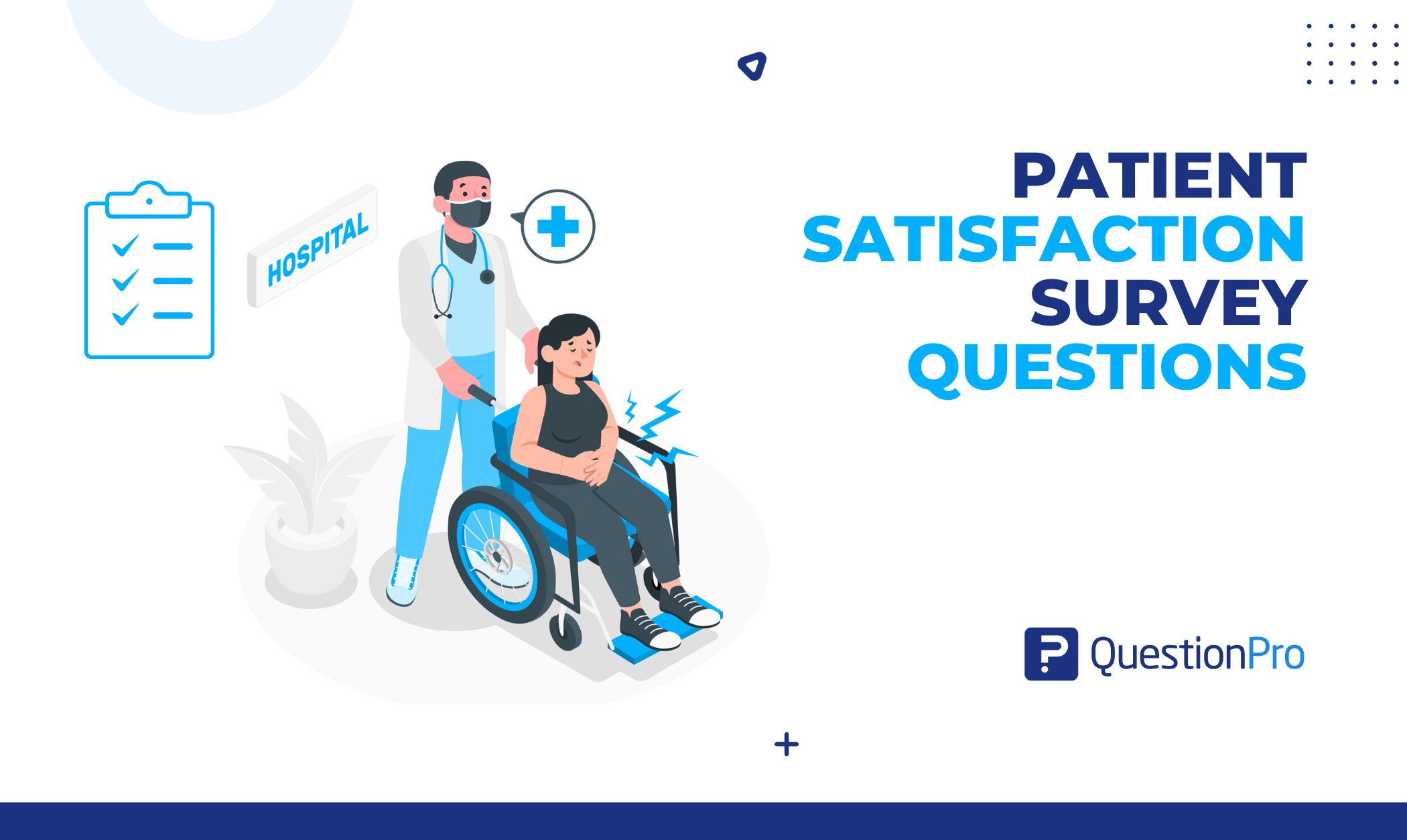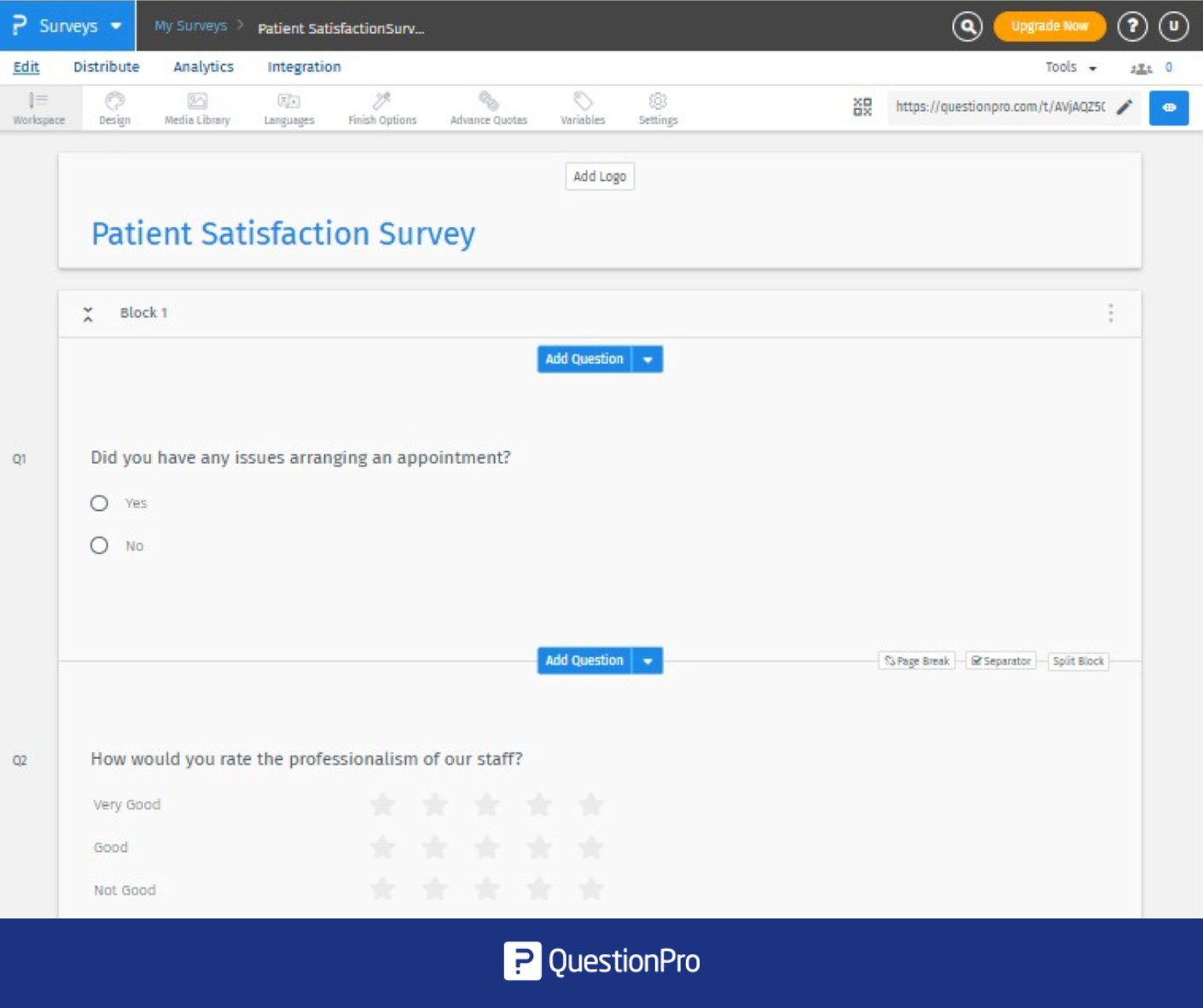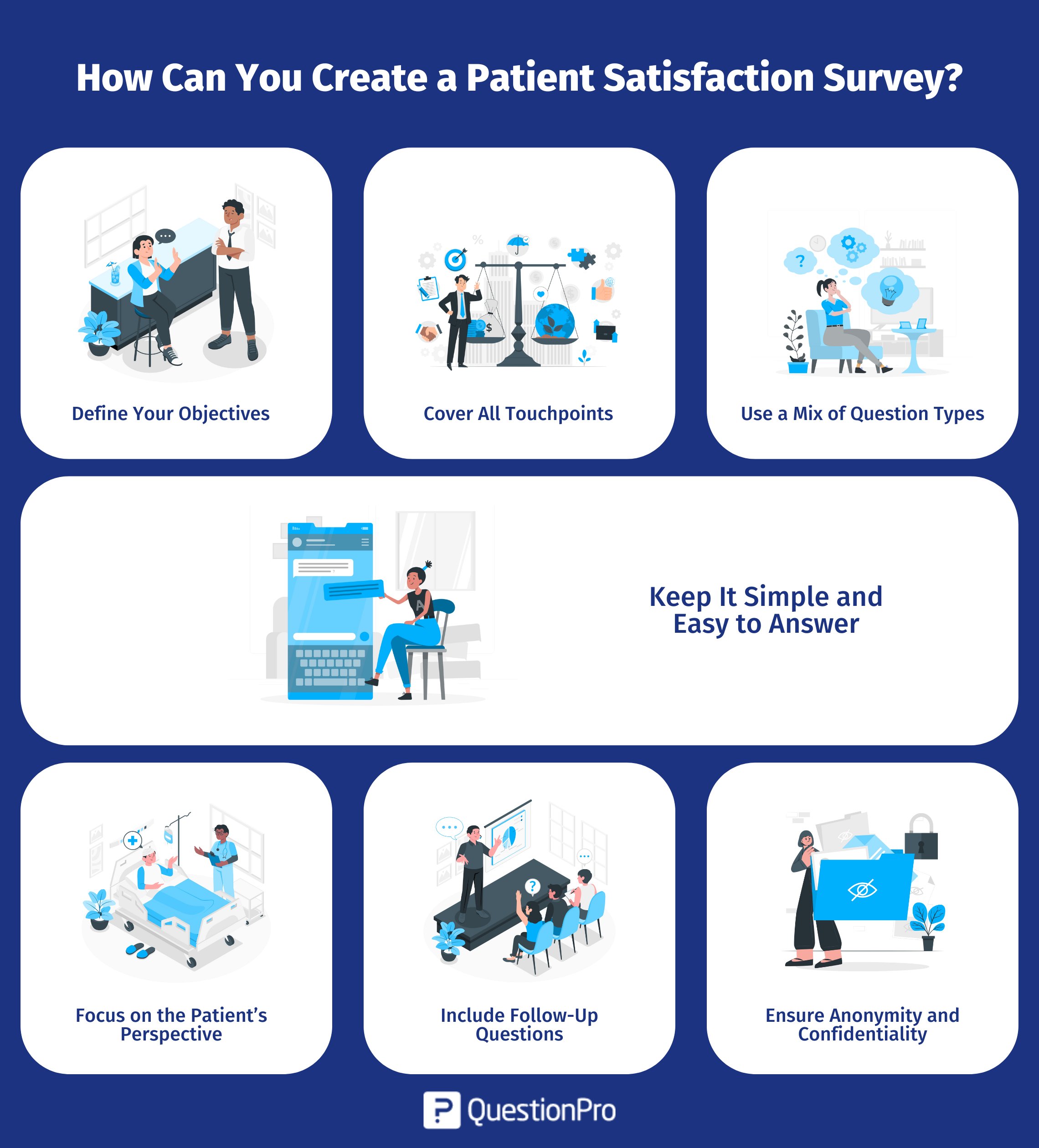
The comfort of hospitalized patients is essential for their physical, emotional, and, in some cases, spiritual recovery. Nursing care provided with quality, safety, and humane care favors critical patients’ well-being and improves response to treatment and quality of life. The patient satisfaction survey questionnaire helps to assess basic metrics through patient care and understand the level of care presented by the institutions and the difficulties in the service, if any. You should also keep the survey disclaimer in mind.
Below, we explain everything you need to know about this powerful tool and share 20 essential questions to include in a patient satisfaction survey to ensure they help you capture actionable insights that will help you improve your service and keep your patients satisfied.
What is a Patient Satisfaction Survey?
A patient satisfaction survey is a set of questions used to collect feedback from patients to measure their satisfaction with the quality and care of the healthcare service provider.
The patient satisfaction survey questionnaire helps adjudge basic metrics across patient care that aid medical institutions in understanding the level of care provided and pitfalls in service.
There are six underlying metrics on which patient satisfaction should be measured:
- Quality of medical care
- Interpersonal skills displayed by medical professionals
- Transparency and communication between the care provider and the patient
- Financial aspects of care
- Access to doctors and another medical professionals
- Accessibility of care
A patient satisfaction survey can be administered anytime during an electronic medical record (EMR) or an electronic health record (EHR). It can be completed via mobile, physical copies of the survey, website, POS device, computers in waiting rooms, or any other medium.
One example of a patient satisfaction survey is the primary trauma survey, where the initial assessment and the management of a trauma patient who enters a medical facility or a hospital are conducted. The second example of a patient satisfaction survey is a secondary trauma survey. It is an in-depth survey template that is carried out to identify the presence of other significant but not immediately life-threatening injuries that were missed in the primary trauma survey. Both these sample survey templates collect data about a patient’s satisfaction with how their trauma was dealt with at a hospital or medical facility.
Why Should You Conduct a Patient Satisfaction Survey?
In many cases, certain facets of a medical facility’s functioning remain unaddressed due to a rare collection of patient feedback and the sheer lack of information regarding those issues faced by patients while availing of consultation and treatment. It is where patient satisfaction surveys provide an effective platform for patients to provide honest feedback based on their experience.
Let’s examine why periodic patient satisfaction surveys are critical to maintaining and growing your patient visitors.
Map and track a patient’s journey
A medical institute needs to track its patients’ journey based on the provided care. To ensure effective patient care and satisfaction at every point of significant interaction with the medical staff and your institution at large, it is always recommended to conduct patient satisfaction surveys at multiple aspects of their journey. It enables you to track the low satisfaction points and remedy them.
Gather data about the patient loyalty
Including a Net Promoter Score or patient satisfaction score question: “Considering your complete experience with our medical facility, how likely would you be to recommend us to a friend or colleague?” – will help you understand how loyal your patients are as each patient will talk to their friends and colleagues about their experience after they are done with their treatment.
Based on their responses, patients will be divided into three categories: Promoters (9-10), Passives (7-8), and Detractors (0-6).
In many cases, if patients have had a terrible experience (i.e., detractors) or a pleasant experience (i.e., promoters), they will talk about the experience within their network of friends and colleagues. While a terrible experience will damage your facility’s reputation, a pleasant experience will help build a positive reputation.
Hospital authorities should calculate their Net Promoter Score at every patient journey touchpoint or towards the end of their treatment. It ensures that issues by detractive patients are addressed, efforts are made to convert passives into promoters, and promoters are kept satisfied with each treatment experience.
Report any ill-treatment by staff members
A patient satisfaction survey template promotes transparency by providing patients a medium to talk about any mistreatment from hospital staff and bring it to the management’s attention. The management team can take a step to either fire those staff members or train them to be respectful towards every patient who visits the medical facility.
Effective patient care
By conducting a patient satisfaction survey, medical institutions can analyze the gap between patient demands and their provisions. Medical facilities can improve visibility into their operational efficiency, which can be used to bridge the identified gap.
Every industry has become customer-centric, and the healthcare sector is no different. There are a considerable number of areas in a medical institution’s operations that need improvement, and this is where learning from the customers directly becomes effective. Your hospital or healthcare organization can include questions about how you can serve the patients better, to keep evolving according to the evolution happening in patients thoughts and opinions.
Offer timely services to patients
8 out of 10 medical authorities believed that they attended to all their patients precisely at their respective appointment slots. Whereas, almost 50% of patients opined otherwise – they never get called in at their precise appointment time.
Gain insights about hygiene levels
Hygiene levels of a hospital reflect how well-maintained it is. There is a significant sample of patients who would prefer visiting a hospital offering clean and hygienic facilities. You can include questions regarding this aspect of the questionnaire.
Recommended free resource: Clinical Supervision Survey Questions + Sample Questionnaire Template.
Sample Patient Satisfaction Survey Questions
Any patient satisfaction survey questionnaire should necessarily cover a few important questions for effective feedback collection. This sample survey can be customized according to the details required by the authorities. Here are the top five questions that should inevitably be a part of your patient satisfaction survey:

Based on your complete experience with our medical care facility, how likely are you to recommend us to a friend or colleague?
Over time, health care has evolved into an extensive industry. When it comes to visiting doctors, trust plays a very significant role. It is why, among all the industries, healthcare is heavily dependent on recommendations from other former or existing patients, based on the care they received and the satisfaction it resulted in. Adding a Net Promoter Score question such as this one can help you understand whether your hospital will get more business from your current patients and their friends/colleagues/families over a considerable time.
Did you have any issues arranging an appointment?
The impact of timely appointment provision on patients is incredible because they are sick or suffer from some ailment and, therefore, must not be kept waiting. It has a significant impact on patient retention and visiting the same medical facility or doctor again. By including this question in the patient satisfaction survey, you can collect information about the timely assignment of appointments and make improvements in the process to increase contentment amongst patients.
How would you rate the professionalism of our staff?
The care of nurses/doctors and the professionalism of administration and ancillary staff members impact patient satisfaction. Ask this question to know whether your staff was courteous and professional, and if proper assistance was provided to the patient.
Are you currently covered under a health insurance plan?
There are certain illnesses that are expensive and are covered under health insurance. As there are cases where mishaps happen and legal allegations are charged against the hospital, each patient’s information is critical, and so is this one. A healthcare insurance survey template can be used to collect information about whether patients have an insurance plan or not.
What Are Some Specialized Patient Satisfaction Survey Questions?
Due to its nature and scale of operation, the healthcare survey has many different nodes of care providers. Timely feedback must be collected at various milestones. The questions will differ from each medical care type, though. Some survey questions for the most significant medical care facilities are:
Hospitals
How would you rate the investigative diagnosis process that you underwent?
Patients often walk into hospitals with localized pain and do not know how to explain the pain and other symptoms to medical care professionals. It requires knowledge and foresight on the part of the medical care professionals to conduct an investigative diagnosis with a mix of patient and family history, conduct tests, and provide essential medication. The medical examination services template will offer you insight into the patient’s experience during the diagnostic process of providing care.
How often did you receive conflicting information from different medical care professionals at this hospital?
One of the most important yardsticks to understand your current staff’s caliber is to map the number of times a patient received conflicting information from different medical care professionals. It will help put in place a process to disseminate information and conduct on-the-job training if required.
What is the difference in the care provided by the hospitals available in your area?
Hospitals must always provide high-quality treatment to all their patients. It is also essential to build on your strengths while implementing best practices from other hospitals in your local area. The healthcare opinion survey template can provide a quick snapshot of how you stand versus your localized peers.
Were your copayments and coinsurances split correctly between Medicare and Medicaid by the hospital?
Being covered under Medicare and Medicaid is not a personal choice but a federal mandate. Hence if the patients are asked insensitive questions about their coverage and billed incorrectly, this drives patients away. Conducting a healthcare well-being survey helps streamline services for the aged and underprivileged.
Primary Care Providers
As a woman, did you feel comfortable talking to the gynecologist?
A lot of women are skeptical about visiting a gynecologist because they are nervous for many reasons. Collecting feedback through a women’s health care survey on how comfortable someone is with visiting or discussing their problem could make it easier to be empathetic and make the patient comfortable.
Is your primary healthcare physician able to conduct a swift diagnosis and prescribe medication?
When someone is ill, the first instinct is to visit the primary healthcare physician and not a hospital. More often than not, this is the only medical care required, but a patient may be forced to access secondary care if the primary care is inadequate. The physician practices survey template can be used to get feedback on care provided as the first point of contact for an unwell person.
Secondary Care Providers
Did the pharmacy staff bill your health provider and collect the right deductible from you for your medicines?
After the Affordable Care Act (ACA), health insurance is now being more widely used. Due to the nature of the payer ecosystem, health plans are varied by state, federal, and private, and hence the deductibles vary. With Trumpcare replacing ACA, point-of-sale medical health providers like pharmacies must bill the patient correctly and collect the right deductibles.
Were the ambulatory staff quick to respond to your medical care request?
Quick responders medical staff are one of the most important medical care providers in the healthcare industry. Timely and effective medical treatment is essential for a patient to be able to make a full recovery. Collecting feedback on each emergency call’s timeliness and effectiveness is important to streamline services and be even more effective.
How often do you visit a dentist in a year?
Patients are generally hesitant to visit dentists due to their lesser knowledge of dental hygiene and the trauma of being in a dentist’s chair. Collecting feedback by using the Oral health survey template can be an important yardstick to measure how comfortable patients are with dentists and how that can be increased.
Specialized Medical Care
Were the staff sensitive towards your addiction?
At times, patients in de-addiction centers do not wish to be there. Being sensitized to the addiction and getting out of it takes a lot of mental courage and hard work. De-addiction center employees need to stay abreast of how comfortable their methods are towards helping patients deal with their addiction and how effective their methodologies are.
Did the psychiatrist diagnose your ailment correctly and provide timely counseling?
Mental health is one of the most ignored ailments and one of the toughest to diagnose because there are fewer visible symptoms. It makes the diagnosis and counseling even tougher. Collecting feedback by using a mental health survey template is very important for a psychiatrist because this helps them be even more effective in their job.
Did the birth home provide good post-natal care?
The birth of a child is one of the most awaited times for a mother and the family. Hence, every aspect of the birthing process has to be top-notch and make the mother and child comfortable without medical complications. Collecting feedback from mothers and families provides a good insight into the quality of care provided.
Did the radiology center provide the scan reports on the same day?
People sometimes visit standalone radiology centers because their health plan does not cover a hospital’s radiology lab. It means that an external radiology center increases the time to diagnosis or taking stock of health improvement. It reduces time to get reports to improve the patient satisfaction level, and the radiology center must work to streamline processes continuously.
Extended Medical Care Organizations
Did the extended medical care facility provide you with helpful inputs about coming back to living in society?
People who have been in an extended medical care facility and are returning to society after many years are not aware of how living by themselves will be after a long period. Counselors at the extended medical care facility should provide guidelines to live by and make the patient aware of the things that have to be done when they go back to living in society.
Rate the experience provided to you by the medical staff in the last 12 months.
Many patients have to stay in an extended medical care facility because of specific ailments, mental health issues, or other conditions requiring constant care. Collecting feedback on their perception of the care provided, what went wrong, and what was done well helps build robust and streamlined care-providing experiences.
Veterinarian
How long did the veterinarian take to diagnose your pet’s ailment?
Diagnosing what is wrong with animals is tougher because symptoms cannot be validated quickly. Hence, a right, timely diagnosis becomes that much more crucial to the health of the pet. Conducting a veterinarian survey helps collect objective, actionable feedback from the pet owner about the treatment process.
How Can You Create a Patient Satisfaction Questionnaire?
Creating an effective patient satisfaction questionnaire involves several key steps to ensure it gathers valuable insights and encourages participation. Here’s a guide on how to develop one:

1. Define Your Objectives
Determine what you want to achieve with the survey. Are you looking to improve the quality of care, communication, facility experience, or patient support? Clear objectives help you shape the questions to be more focused and relevant.
2. Cover All Touchpoints
Ensure the questionnaire addresses every stage of the patient journey, from scheduling appointments to post-visit care. This holistic approach allows you to map out problem areas and pinpoint specific issues.
3. Use a Mix of Question Types
Include various question types to collect different kinds of data:
- Closed-ended questions for quantitative insights (e.g., “How satisfied were you with your visit?”).
- Rating scale questions to understand the degree of satisfaction (e.g., “Rate your satisfaction on a scale of 1 to 10”).
- Open-ended questions to allow patients to elaborate on their experiences and provide specific feedback (e.g., “What improvements would you suggest for our waiting area?”).
4. Keep It Simple and Easy to Answer
Use clear and straightforward language to make questions easy to understand. Avoid medical jargon, and keep sentences concise. An easy-to-answer survey encourages more responses and reduces drop-off rates.
5. Focus on the Patient’s Perspective
Design questions that center around the patient’s experience. For example, “Did your provider explain your treatment plan clearly?” captures how well the patient understood their care.
6. Include Follow-Up Questions
To understand the extent of a problem, add follow-up questions when patients report dissatisfaction. For instance, if someone rates the waiting time poorly, a follow-up could be, “What would you suggest to reduce wait times?”
7. Ensure Anonymity and Confidentiality
Inform patients that their responses will remain confidential and will only be used to enhance service quality. This assurance promotes honest and open feedback.
HIPAA Compliance for Patient Satisfaction Surveys
Patient care and the medical field are governed by a heightened sense of data integrity. Patients are skeptical about providing medical information because the perception is that the information provided should be treated with extreme confidentiality and care.
Health Insurance Portability and Accountability Act (HIPAA) ensures that there is a standard for data collection of sensitive patient information. Under the HIPAA privacy regulations, medical institutions are allowed to conduct assessment surveys for patient care and, in general, collect actionable feedback for healthcare operations. Feedback on the quality of care provided by medical professionals as part of a safety survey or questionnaire that a patient answers is considered a quality assessment and improvement activity and is part of the healthcare operations. If any medical care provider collects patient health information (PHI), then that caregiver is bound by HIPAA compliance.
If the patient provides feedback or answers to the survey as “confidential communication”, then, as per HIPAA compliance, the patient’s request has to be respected and carried out as requested. QuestionPro has HIPAA-compliant survey questions that you can readily deploy to elicit feedback from patients. It ensures that you can only focus on the feedback and not worry about being legally compliant with collecting PHI.
HIPAA also provides that when PHI is collected, if there are ICD-10 or ICD-11 codes in the survey template, they are adequately marked out, and each code is also specified in detail so that the patient is aware of the payer and provider technical information.
Knowing the degree of satisfaction of the clients and patients of a health services company, whether it is a Clinic, a Medical Center, a Health and Beauty Center, or a private Consultation, is essential to grow and offer adequate services to generate satisfaction. And loyalty. It is a basic element that leads to the success and growth of your business.
Patients’ opinion is the most significant source of information to improve the services of a Clinic or Medical Center. They are the ones who will give us the points to improve and find, perhaps, the reason why customers are being lost. Offering what they need is the key to building loyalty and attracting new customers.
Conclusion
Creating a patient satisfaction survey that is engaging, easy to answer, and helps capture meaningful feedback. By combining open-ended questions with other types and addressing all stages of patient care, you can gather insights that guide targeted improvements and enhance overall patient satisfaction.
Do you want to create a survey for your patients? Request a demo of our online survey software, QuestionPro, today!
Frequently Asked Questions (FAQs)
Answer: Conducting a survey helps healthcare facilities understand patient needs, track satisfaction, identify issues, and improve care quality. It also aids in building patient loyalty and addressing concerns like appointment scheduling and staff professionalism.
Answer: By collecting feedback, hospitals and clinics can identify service gaps, improve patient care, address issues with staff or processes, and enhance overall patient satisfaction.
Answer: To create an effective survey, define objectives, cover all patient interaction points, use varied question types (closed, rating scales, open-ended), keep it simple, and ensure confidentiality.
Answer: Yes, surveys can be HIPAA-compliant if they respect patient privacy and ensure data confidentiality. It’s crucial for healthcare providers to follow HIPAA guidelines when collecting sensitive patient information.
Answer: Surveys should be conducted regularly, ideally after key interactions such as appointments, treatments, or hospital stays, to capture timely feedback and improve patient care consistently.







